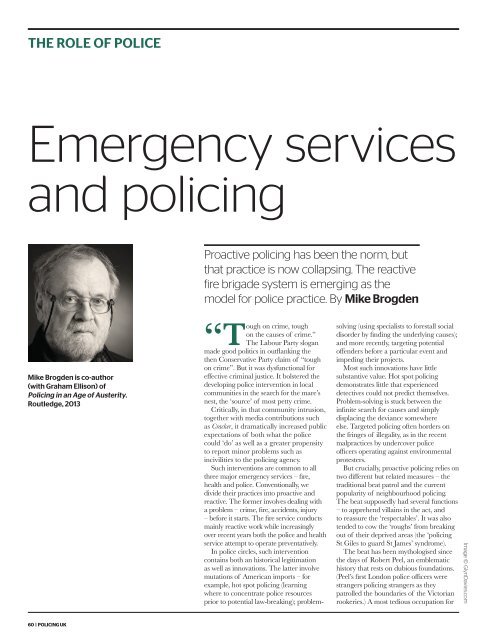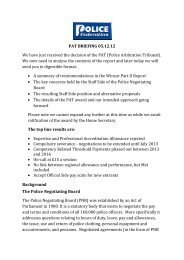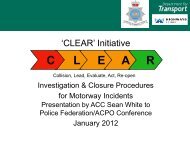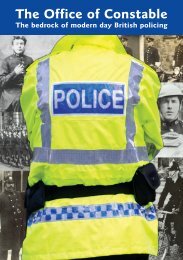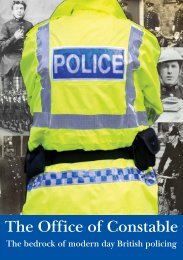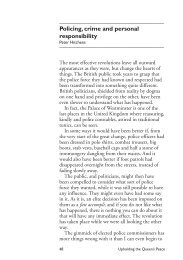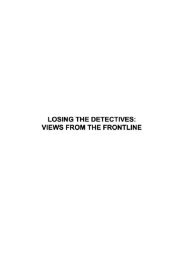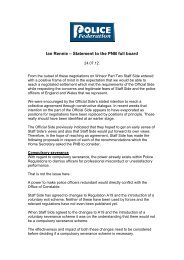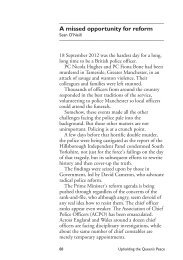Policing UK 2013 - Police Federation
Policing UK 2013 - Police Federation
Policing UK 2013 - Police Federation
Create successful ePaper yourself
Turn your PDF publications into a flip-book with our unique Google optimized e-Paper software.
THE ROLE OF POLICE<br />
Emergency services<br />
and policing<br />
Proactive policing has been the norm, but<br />
that practice is now collapsing. The reactive<br />
fire brigade system is emerging as the<br />
model for police practice. By Mike Brogden<br />
Mike Brogden is co-author<br />
(with Graham Ellison) of<br />
<strong>Policing</strong> in an Age of Austerity.<br />
Routledge, <strong>2013</strong><br />
on crime, tough<br />
on the causes of crime.”<br />
“Tough<br />
The Labour Party slogan<br />
made good politics in outflanking the<br />
then Conservative Party claim of “tough<br />
on crime”. But it was dysfunctional for<br />
effective criminal justice. It bolstered the<br />
developing police intervention in local<br />
communities in the search for the mare’s<br />
nest, the ‘source’ of most petty crime.<br />
Critically, in that community intrusion,<br />
together with media contributions such<br />
as Cracker, it dramatically increased public<br />
expectations of both what the police<br />
could ‘do’ as well as a greater propensity<br />
to report minor problems such as<br />
incivilities to the policing agency.<br />
Such interventions are common to all<br />
three major emergency services – fire,<br />
health and police. Conventionally, we<br />
divide their practices into proactive and<br />
reactive. The former involves dealing with<br />
a problem – crime, fire, accidents, injury<br />
– before it starts. The fire service conducts<br />
mainly reactive work while increasingly<br />
over recent years both the police and health<br />
service attempt to operate preventatively.<br />
In police circles, such intervention<br />
contains both an historical legitimation<br />
as well as innovations. The latter involve<br />
mutations of American imports – for<br />
example, hot spot policing (learning<br />
where to concentrate police resources<br />
prior to potential law-breaking) problemsolving<br />
(using specialists to forestall social<br />
disorder by finding the underlying causes)<br />
and more recently, targeting potential<br />
offenders before a particular event and<br />
impeding their projects.<br />
Most such innovations have little<br />
substantive value. Hot spot policing<br />
demonstrates little that experienced<br />
detectives could not predict themselves.<br />
Problem-solving is stuck between the<br />
infinite search for causes and simply<br />
displacing the deviance somewhere<br />
else. Targeted policing often borders on<br />
the fringes of illegality, as in the recent<br />
malpractices by undercover police<br />
officers operating against environmental<br />
protesters.<br />
But crucially, proactive policing relies on<br />
two different but related measures – the<br />
traditional beat patrol and the current<br />
popularity of neighbourhood policing.<br />
The beat supposedly had several functions<br />
– to apprehend villains in the act, and<br />
to reassure the ‘respectables’. It was also<br />
tended to cow the ‘roughs’ from breaking<br />
out of their deprived areas (the ‘policing<br />
St Giles to guard St ames’ syndrome).<br />
The beat has been mythologised since<br />
the days of Robert Peel, an emblematic<br />
history that rests on dubious foundations.<br />
(Peel’s first London police officers were<br />
strangers policing strangers as they<br />
patrolled the boundaries of the Victorian<br />
rookeries.) A most tedious occupation for<br />
Image © GlynDavies.com<br />
60 | POLICING <strong>UK</strong>


